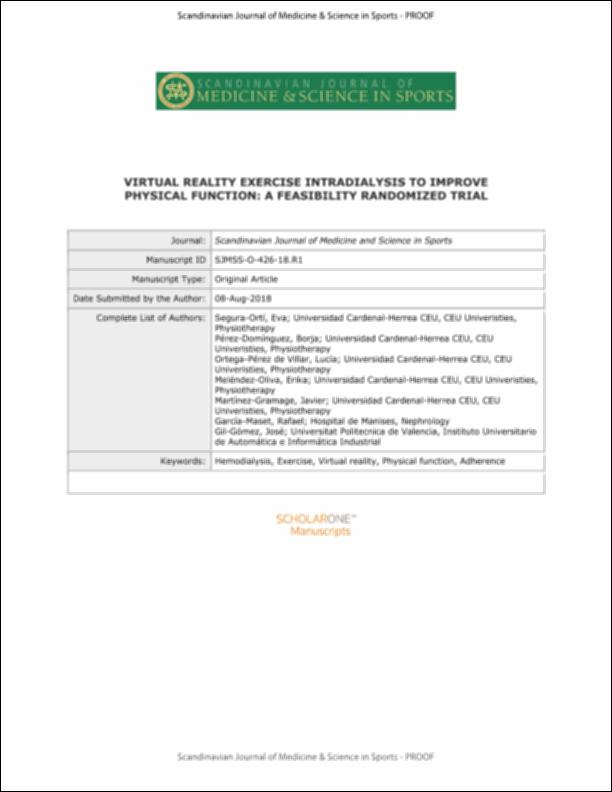Por favor, use este identificador para citar o enlazar este ítem:
http://hdl.handle.net/10637/10625Virtual reality exercise intradialysis to improve physical function : a feasibility randomized trial
| Título : | Virtual reality exercise intradialysis to improve physical function : a feasibility randomized trial |
| Autor : | Segura Ortí, Eva Pérez Domínguez, Francisco de Borja Ortega Pérez de Villar, Lucía Meléndez Oliva, Erika Martínez Gramage, Javier García Maset, Rafael Gil Gómez, José Antonio |
| Materias: | Exercise - Computer simulation.; Realidad virtual.; Hemodiálisis.; Physical theraphy - Technological innovations.; Ejercicio físico - Simulación por ordenador.; Virtual reality.; Fisioterapia - Innovanes tecnológicas.; Hemodialysis. |
| Editorial : | John Wiley & Sons. |
| Citación : | Segura-Ortí, E., Pérez-Domínguez, B., Ortega-Pérez de Villar, L., Meléndez-Oliva, E., Martínez-Gramage, J., García-Maset, R. et al. (2019). Virtual reality exercise intradialysis to improve physical function : a feasibility randomized trial. Scandinavian Journal of Medicine & Science in Sports, vol. 29, n. 1 (jan. 2019), pp. 89-94. DOI: https://doi.org/10.1111/sms.13304 |
| Resumen : | Objective: The main objective of this investigation was to assess feasibility of conducting a future RCT with an intradialysis non-immersive virtual reality exercise intervention. The secondary aim was to explore the impact of either conventional or VR exercise on physical function. Design: Feasibility randomized trial Participants: 18 subjects who participated in a 16 weeks intradialysis combined exercise program. Interventions: The program lasted 4 additional weeks of either combined exercise or virtual reality exercise. Main outcome measures: Physical function was measured through several reliable tests (sit to stand to sit tests 10 and 60, gait speed, one-leg heel rise tests and 6-minute walk test) at baseline, after 16 weeks of intradialysis combined exercise and by the end of 4 additional weeks of exercise. Adherence to the exercise programs was registered. Results: There was a significant time effect, so that physical function improved in both groups. By the end of the 20 weeks, function improved as measured through the sit to stand to sit test 10 and 60, gait speed, one-leg heel rise left leg and the 6-minute walk test. Changes that did not occur due to error in the test were seen after 20 weeks were achieved in the sit to stand to sit test 60, gait speed, one-leg heel rise test for the left leg and 6-minute walking test. Conclusion: Virtual reality was a feasible intervention. Both interventions improved physical function. Adherence was not significantly different between groups. |
| Descripción : | Este artículo se encuentra disponible en la siguiente URL: https://onlinelibrary.wiley.com/doi/full/10.1111/sms.13304 |
| URI : | http://hdl.handle.net/10637/10625 |
| Derechos: | http://creativecommons.org/licenses/by-nc-nd/4.0/deed.es |
| ISSN : | 0905-7188 1600-0838 (Electrónico) |
| Fecha de publicación : | 2-ene-2019 |
| Centro : | Universidad Cardenal Herrera-CEU |
| Aparece en las colecciones: | Dpto. Enfermería y Fisioterapia |
Los ítems de DSpace están protegidos por copyright, con todos los derechos reservados, a menos que se indique lo contrario.


